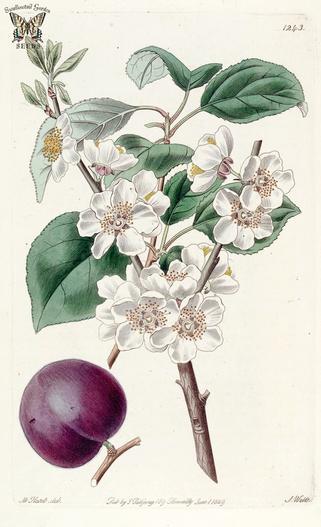Purple Apricot
(Prunus ×dasycarpa)
Purple Apricot (Prunus ×dasycarpa)
/
/

Swallowtail Garden Seeds
PDM 1.0
Image By:
Swallowtail Garden Seeds
Recorded By:
Copyright:
PDM 1.0
Copyright Notice:
Photo by: Swallowtail Garden Seeds | License Type: PDM 1.0 | License URL: https://creativecommons.org/publicdomain/mark/1.0/ | Uploader: Swallowtail Garden Seeds | Publisher: Flickr

Estimated Native Range
Summary
Prunus ×dasycarpa, commonly known as Purple Apricot or Black Apricot, is a deciduous tree that is believed to be a hybrid between Prunus armeniaca (Apricot) and Prunus cerasifera (Cherry Plum). It was named by Jakob Friedrich Ehrhart in 1791. This tree is characterized by its reddish-orange buds and white blossoms that appear in early spring, offering a striking display. The exact origin of Purple Apricot is debated, but it is thought to be either a human-cultivated hybrid or a naturally occurring one from Western Asia, particularly in areas with temperate climates.
Purple Apricot trees are valued for their ornamental flowers and are often used in gardens and landscapes for their visual appeal. They can grow in a variety of soil types, provided they are well-drained, and they prefer full sun to part shade. While not as common as other fruit trees in cultivation, they can be planted as specimen trees or in mixed borders. Care should be taken as they can be susceptible to common stone fruit diseases such as bacterial canker and peach leaf curl. The tree’s fruit, if produced, is edible and has a unique flavor, though it is not widely cultivated for fruit production.CC BY-SA 4.0
Purple Apricot trees are valued for their ornamental flowers and are often used in gardens and landscapes for their visual appeal. They can grow in a variety of soil types, provided they are well-drained, and they prefer full sun to part shade. While not as common as other fruit trees in cultivation, they can be planted as specimen trees or in mixed borders. Care should be taken as they can be susceptible to common stone fruit diseases such as bacterial canker and peach leaf curl. The tree’s fruit, if produced, is edible and has a unique flavor, though it is not widely cultivated for fruit production.CC BY-SA 4.0
Plant Description
- Plant Type: Tree, Shrub
- Height: 7-10 feet
- Width: 7-10 feet
- Growth Rate: Moderate
- Flower Color: White, Pink
- Flowering Season: Spring
- Leaf Retention: Deciduous
Growth Requirements
- Sun: Full Sun
- Water: Medium
- Drainage: Medium, Fast
Common Uses
Bird Garden, Border Plant, Low Maintenance, Showy Flowers
Natural Habitat
Temperate climates of Western Asia
Other Names
Common Names: Purple Sand Cherry, Plumleaf Sand Cherry
Scientific Names: , Prunus ×dasycarpa, Armeniaca atropurpurea var. persicifolia, Armeniaca dasycarpa, Armeniaca dasycarpa, Armeniaca fusca, Armeniaca sibirica var. dasycarpa, Armeniaca ×atropurpurea, Armeniaca ×dasycarpa subsp. persicifolia, Armeniaca ×dasycarpa var. patakii
GBIF Accepted Name: